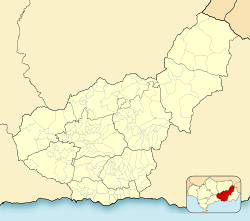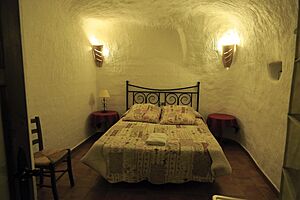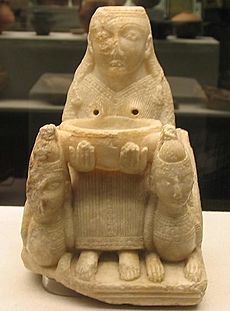Galera, Granada facts for kids
Quick facts for kids
Galera
|
||
|---|---|---|
|
||
| Country | ||
| Autonomous community | ||
| Province | Granada | |
| Comarca | Huéscar | |
| Judicial district (partido judicial) | Huéscar | |
| Area | ||
| • Total | 117 km2 (45 sq mi) | |
| Elevation | 843 m (2,766 ft) | |
| Population
(2018)
|
||
| • Total | 1,090 | |
| Demonym(s) | galerino (m.), galerina (f.) | |
| Time zone | UTC+1 (CET) | |
| • Summer (DST) | UTC+2 (CEST) | |
| Postal Code |
18840
|
|
| Area code(s) | (+34) 958 | |
| Province code | 18 | |
| Municipality code | 082 | |
| Distance from Granada | 150 km | |
Galera is a small town, also called a municipality, located in the Huéscar region of Granada, Spain. It's part of the autonomous community of Andalusia. Galera is about 150 kilometers (93 miles) away from the main city of Granada.
People have lived in the Galera area since ancient times, long before written history. The town is special because it has two very important archaeological sites. It's also known for its many unique cave houses, which are homes built right into the side of hills!
Contents
People of Galera
The number of people living in Galera has changed over the years. In 2018, about 1,090 people lived there. The town's population is spread out among a few smaller areas, or districts.
| District | Number of People |
|---|---|
| Buenavista | 15 |
| Cortijos del Cura | 35 |
| Galera | 979 |
| La Alquería | 105 |
You can see how the population has changed over time in the table below:
| Historical population | ||||||||||||||||||||||||||||||||||||||||||||
|---|---|---|---|---|---|---|---|---|---|---|---|---|---|---|---|---|---|---|---|---|---|---|---|---|---|---|---|---|---|---|---|---|---|---|---|---|---|---|---|---|---|---|---|---|
|
|
|
||||||||||||||||||||||||||||||||||||||||||
Exploring Galera's Ancient Past
Galera has a rich history, especially when it comes to ancient times. Two major archaeological sites near the town tell us a lot about the people who lived here long ago.
The Bronze Age at Castellón Alto
One important site is called "Castellón Alto," or "Castellón de Arriba." Here, archaeologists have found traces of the Bronze Age Argaric culture. They've dug up many ancient tombs on different levels of a hill with steep sides.
Amazing Discoveries at Castellón Alto
Among the exciting finds at Castellón Alto was a mummified body. This incredible discovery is now on display in Galera's local museum, giving us a glimpse into ancient burial practices.
The Iberian Necropolis of Tutugi
Another very important site is an Iberian burial ground, or necropolis, called Tútugi. It's located on a hill right above the modern village. This hill is also known as Cerro del Real. Sometimes, the name Tutugi is used to refer to Galera itself in ancient times.
Archaeologists have carefully studied this necropolis. They found different types of tombs there. The most common type is a rectangular room covered by a round mound of earth, called a tumulus. You could reach these tombs through a long passage.
Treasures from Tutugi's Tombs
Many fascinating objects have been found in these tombs. These include beautiful ornaments, vases from Phoenicia, Ancient Greece, and Iberia, and even ancient weapons. They also found special items buried with the dead, like alabaster clay figures. These items date back to between the 6th and 3rd centuries BCE (Before Common Era).
One of the most famous finds is the "Lady of Galera" or "Goddess of Galera." This small statue was discovered in a tomb from the 5th century BCE. It's a Phoenician figurine from the 7th century BCE, made of alabaster. It probably represents the goddess Astarte. The statue's strong shape suggests influences from Mesopotamia, while its clothing and hair styles show Egyptian influences. Experts believe this sacred object was passed down through many families before being buried with someone. Today, you can see it on display in Madrid.
Galera Through the Ages
Galera continued to be an important place during the Roman era, known as "TVTVGI." However, its population decreased a bit during the time of the Visigoths and when Muslims ruled Al-Andalus.
From Conquest to Repopulation
In 1230, Rodrigo Jiménez de Rada, an archbishop, took control of Galera. But then, in 1319, Ismail I of Granada got it back. Finally, in 1488, during the rule of the Catholic Monarchs Isabella and Ferdinand, Galera became part of Castile for good.
In 1568, the people of Galera, known as Moriscos, took part in a big revolt. This revolt was personally put down by Don John of Austria. The town faced a terrible event where many people lost their lives, and the fields were even salted so crops couldn't grow. This sad event is known as the Galera Massacre. After this, in the 16th century, new families came to live in Galera, mostly from places like Valencia, Murcia, and La Mancha.
See also
 In Spanish: Galera (Granada) para niños
In Spanish: Galera (Granada) para niños







